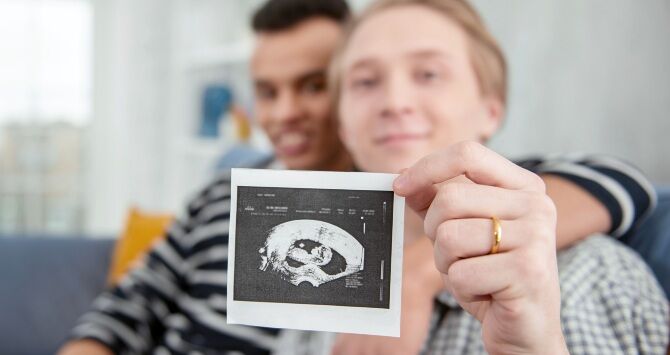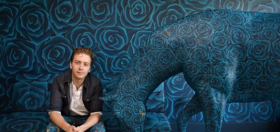
In a world first, scientists in Japan have created a baby mouse with two fathers. Instead of using an egg cell from a female, they were able to take a skin cell from one of the male mice and convert it into an egg. They then fertilized this with a sperm cell from the other male.
The research points toward the possibility of radical new treatments for infertile couples. It also suggests that someday in the future, a male couple could have a biological child together using a mixture of just their own DNA, and not a surrogate egg donor.
A surrogate would still need to carry the child.
“This is the first case of making robust mammal oocytes from male cells,” said Katsuhiko Hayashi, who led the work at Kyushu University in Japan.
How about we take this to the next level?
Our newsletter is like a refreshing cocktail (or mocktail) of LGBTQ+ entertainment and pop culture, served up with a side of eye-candy.
Hayashi presented the results at the Third International Summit on Human Genome Editing at the Francis Crick Institute in London yesterday.
Related:
Gay dads celebrated in a beautiful new photography book
Happy Father’s Day to all these dads!
“Purely in terms of technology, it will be possible [in humans] even in 10 years,” said Hayashi. He indicated he would be happy for gay men to make use of the procedure if it was shown to be safe in humans.
However, he recognized there were bigger ethical implications.
“I don’t know whether they’ll be available for reproduction,” he said. “That is not a question just for the scientific program, but also for [society].”
“Significant potential applications”
The research was partly driven to see if fertility was possible for women who have Turner Syndrome. The genetic disorder is carried only on female chromosomes.
Other scientists described Hayashi’s 10-year prediction as wildly optimistic. It’s not been possible to convert a human female cell into a lab-grown egg as yet, let alone a male cell.
“We still don’t understand enough of the unique biology of human gametogenesis to reproduce Hayashi’s provocative work in mice,” Prof George Daley, the dean of Harvard Medical School, told The Guardian.
Despite this, news of the research has prompted interest around the world.
“This is a significant advance with significant potential applications,” Keith Latham, a developmental biologist at Michigan State University in East Lansing, told Nature.
Although presented at yesterday’s seminar, Hayashi’s work has yet to be submitted to a journal for peer review.
How they managed it
The work saw the male skin cells reprogrammed into a stem cell-like state. Female cells have XX chromosome pairings. Males have XY. In this case, the male Y-chromosome was removed and replaced with an X-chromosome from another cell. The cell then had the XX chromosome pairing.
The cells were cultivated in a culture system designed to replicate the conditions inside a mouse ovary.
The team was able to produce 600 embryos using this method. This resulted in the birth of seven mouse pups. That’s around a 1% success rate.
The mice appeared to grow as normal. As adults, they went on to father children of their own and live a normal lifespan.
Related:
Son writes movingly of his gay dads, lost to AIDS within a week of each other
“I wonder if they ever look down on me, my brothers and the world and think, Wow, I’m proud!”























cuteguy
Such a beautiful thought to think that two loving fathers can procreate together
inbama
If it weren’t for the ethical questions about renting a woman’s womb.
And of course, this will be a privilege only wealthy gay men could afford.
RIGay
What a beautiful thought! I could see my husband and I doing this, providing we’re not in our 70’s when this become closer to reality.
heyitsleo
Nothing unethical about it surrogacy is a job for a lot of women they do it to help others and get paid and most women I know would atleast consider it. It’s legal in the U.s. and a lot of other places so this would be no different
UlfRaynor
This is nothing new. Japanese scientist in 2011 got similar results converting bone marrow cells into active ovum.
Of course, they didn’t set out to do that. They were working off a theory by another scientist who speculated that it might be possible to convert female bone marrow cells into sperm, thus enabling women to illuminate the need for male participation in reproduction, but they were unable to accomplish that goal, however they did find, with limited success, they could create viable eggs.
The scientist wanted to continue their studies, but when they didn’t achieve the original goal, their funding was cut.
Glad to see someone else followed through with the research.
I’ve read a fair amount of research on this topic and the biologist I’ve talked with, have said we are within just a few years of having artificial wombs.
Seems like an interesting follow up to this story if you ask me Queerty writers.
RIGay
Wow! This will certainly set the Christian Reicht on edge! Waiting to see them dance around legislation to ban this in the US, too.
Mister P
I wish gay men would adopt from the tens of thousands of children already born around the world.
Ronbo
It’s a nice thought, however, it’s not going to happen in anti-LGBTQ countries. Back in 2010 the LGBT community was dismayed to learn that Hillary Clinton opposed a pretty simple change to the State Department’s policy about listing parents on passports. The legislation, which she opposed allowed same-sex parents to list their relationship to children as Parent 1 and Parent 2.
Clinton wrote to her staff, in 2010, that she “could live” with “letting people in nontraditional families choose another descriptor so long as we retained the presumption of mother and father.”
We need to improve whom we choose to support – especially in 73 countries where being LGBT can be punishable by Law – some even death! Such subtle bigotry supports overt bigotry. ONLY “mother and father”, not ‘father and father’ or ‘mother and mother’ or even “parent 1 and parent 2”. I hope her “marriage will ALWAYS be between one man and one woman” and her vociferous support of unconstitutional homophobic DADT and DOMA is history also. We need to actually move beyond such bigotry in all forms.
Chrisk
Ronbo
Yes it’s all Hillary’s fault! LMAO
Except she evolved a long time ago and isn’t even in politics today. When are you Repug clowns going to drop that BS?
Kangol2
Really impressive scientific research. The right-wingers heads are going to blow off over this one!
Ronbo
Yep. It’s going to irk the “right-wingers” who supported unconstitutional, anti-LGBTQ policy including Don’s Ask Don’t Tell, Defense of Marriage Act, and scrubbing same-sex adoption from the State Department forms and communications. Let’s hope our own elder “Proud conservative” doesn’t get angry and run for the Presidency again. Let’s hope and work to remove bigots from ALL of our government.
Thank God for Joe Biden and Bernie Sanders.
Chrisk
Again ancient history Ronbut.
Legit meetup
Nice one
inbama
Can’t wait to see the photospread of Sam Smith giving birth via caesarian from their implanted womb harvested from a 17 year old transman.
Try topping that, Tom Daley!
scotty
i honestly can’t see tom daley topping anything. unless he’s on top of my face.
UlfRaynor
You’ll be waiting a very long time. Biological male anatomy lacks the necessary internal wiring and plumbing to maintain, let alone operate a uterus.
The same holds true for biological females. Even if they could “bleach out” all the possible genetic differences to male reproductive organs, their bodies still lack the necessary internal connections to operate it independent of continuous external manipulation.
SELA Rising
Unpopular Opinion Alert:
[Gay Mens] Vanity Project.
I appreciate scientific advances, but there are plenty of children in the US foster care system who need loving homes. Children all over he world really.
I believe that foster/adoptive parents are truly the ones that can love unconditionally.
Bio-parents (at no fault of their own), and people using surrogates use the condition of biology to love their child.
Gay men using donors feel the need to “see themselves” in the child.
Most foster /adoptive parents recognize that they don’t need that biological link to feel connected to, and to love, that child.
Scientific advances don’t always mean social progress.
inbama
Couldn’t we take a step back from near craziness and medicalization and do what we used to do: challenge the lies that are holding us back – in this case from fostering and adopting. Maybe it’s time we reminded the world of bisexual Josephine Baker and her “rainbow tribe.”
heyitsleo
Maybe I want to pass on my DNA to my children ? Is it wrong that I want that instead of adopting blessings to the people who do but it’s not for everyone there should be choices
Tallskin5
oh god the cross dressing straight blokes with a sexual kink will love this
The tranz-ees have already started feeding their poor kids with puss from their artificially induced breasts
UlfRaynor
Actually… males do have the capacity to produce milk.
Medical disruptions involving prolactin in males, the hormone necessary to produce milk, have resulted in spontaneous lactation. Thorazine, a formerly popular antipsychotic impacts the pituitary gland (the pea-size endocrine gland located near the base of the brain) often causing it to overproduce prolactin. If prolactin levels remain high, milk could follow.
Some teenage males, in the later stages of puberty, have been known to lactate sporadically.
LumpyPillows
More likely women will figure out how to do away with us first.